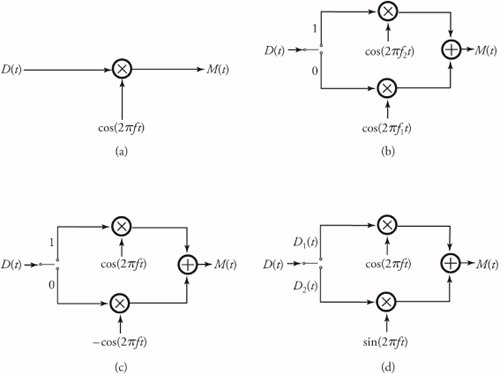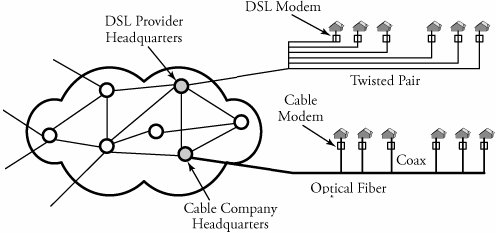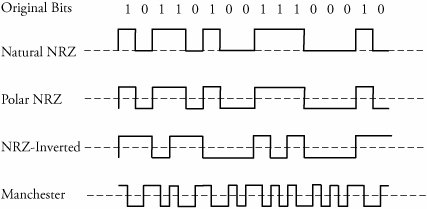Section 3.2. Modems and Internet Access Devices
3.2. Modems and Internet Access DevicesUsers access the Internet from residential areas primarily through modems . A modem ( modulation/demodulation unit ) is a device that converts the digital data to a modulated form of signal that takes less bandwidth. A modem is required to create an appropriate digital signal to access the Internet. A user can access the Internet by using either the existing telephone link infrastructure or the existing cable TV infrastructure. As a result, an Internet user has several choices of modems. Two commonly used ones are the digital subscriber line (DSL) modem and the cable modem (Figure 3.5). A DSL company uses the existing twisted-pair copper lines to provide Internet access; a cable TV company uses optical fibers and coaxial cables to provide that access. Figure 3.5. The choice of DSL modem or cable modem in residential areas for Internet access 3.2.1. Line Coding MethodsBefore processing a raw signal for modulation, a line coding process is performed on binary signals for digital transmission. With line coding, a binary information sequence is converted into a digital code. This process is required to maximize bit rate in digital transmission. Encoding process is essential to also recover the bit timing information from the digital signal so that the receiving sample clock can synchronize with the transmitting clock. The timing synchronization is especially crucial in the performance of LANs. Other reasons for line coding are reduction in transmitted power, and removal of DC voltage from transmission lines. Typically, the cost and complexity of a line encoder is the main factor in the selection of encoder for a given application. Figure 3.6 shows several practical line coding techniques for computer communications. Encoded signals are produced by the line codes for the binary sequence 1011 0100 1110 0010. The simplest form of line coding is the natural nonreturn-to-zero (NRZ) where a binary 1 is represented by a + V voltage level, and a 0 is represented by a 0 voltage. The average transmitted power in this method is (1/2) V 2 + (1/2)0 2 = V 2 / 2. This method creates an average of V/ 2 DC voltage on the transmission lines which is not popular for LAN systems. Figure 3.6. Typical line coding techniques for computer communications. A more power-efficient line coding method is known as polar NRZ . In this method, a binary 1 is mapped to + V/ 2 and a binary 0 is represented by - V/ 2. The average power is then given by (1 / 2)(+ V/ 2) 2 + (1 / 2)(- V/ 2) 2 = V 2 / 4. On average, this method has no DC component and is suitable in most networking applications. A problem with natural and polar NRZ coding methods is that a polarity error can cause all 1s to be delivered as 1s and all 1s as Os. As a solution to this problem the NRZ-inverted method is introduced. With the NRZ-inverted coding, the binary information is mapped into transitions at the beginning of each interval so that a binary 1 is converted to a transition at the beginning of a bit time and a 0 having no transition, and the signal remains constant during the actual bit time. Notice that, errors in this method of encoding occur in pairs. This means that any error in one bit time generates a wrong basis for the next time leading to a new error in the next bit. From the frequency stand-point, both the natural NRZ and NRZ-inverted methods produce spectrum starting from very low frequencies close to zero due to existence of either DC components or less frequent transitions of 0s to 1ns or vice versa. Although, the bipolar NRZ has a better spectrum distribution in this sense, the immunity to noise can still be an issue for all three types of NRZ coding. Low frequencies can also be a bottleneck in some communication systems, as telephone transmission systems, do not pass the frequencies below 200 Hz. To overcome this issue, the Manchester encoding method is introduced. With the Manchester encoding method, a binary 1 is represented by a 1 plus a transition to 0 and then a 0; and a binary 0 is represented by a 0 plus a transition to 1 and then a 1. A great feature of the Manchester encoding is that it is self-clocking. The fact that the each binary bit contains a transition at the middle of its timing makes the timing recovery very easy. From the frequency standpoint, the bit rate is doubled compared with NRZ methods that significantly enhances the shape of its spectrum where lower frequencies are shifted up. This method of line encoding is suitable for LANs especially for Gigabit Ethernets to be discussed in Chapter 5. 3.2.2. Digital Modulation TechniquesIn order to reduce the bandwidth of digital signals, digital modulation technique is required before any transmission. In a modulation process, the amplitude, phase, or frequency of a carrier signal varies with the variations of a digital information signal. Depending on the nature and objective of a modem, the following schemes can be used:
Knowing the types of modulation techniques, we now study the two types of modems for accessing the Internet: digital subscriber line (DSL) modems and cable modems. Figure 3.7 shows the implementation of ASK, FSK, PSK, and QAM systems. In an ASK system, incoming data, D(t ), containing binary 0s and 1s, is modulated over a constant-frequency and constant amplitude sinusoidal carrier signal, cos 2 f t , where f is the frequency of the carrier. The resulting modulated signal is represented by a cosine with the same frequency f where a binary 1 is present, and no signal when a binary 0 is present. In other words, if we multiply our binary data by a constant cosine, we obtain the ASK-modulated version of our data, M(t ) = D(t ) cos(2 f t ). At the receiver, the ASK demodulator only needs to determine the presence or absence of the sinusoid in a given time interval in order to detect the original data. In practice, D(t ) can be extracted at the receiver if M(t ) is multiplied by the same carrier signal but with doubled amplitude, 2 cos(2 f t ), as follows : Equation 3.9 Figure 3.7. The four modulation techniques: (a) ASK, (b) FSK, (c) PSK, and (d) QAM Note that cos(4 f t ) component can be easily filtered out. The FSK scheme is a bit more complicated compared to the ASK scheme. In a FSK modulator , there are two different sinusoidal carriers : f 1 to represent a binary 1 and f 2 to represent binary 0. Therefore, FSK and ASK are similar in the sense that we multiply binary data by a constant sinusoid to obtain the modulated version of data, and they are difference is the sence that three is a sinusoid when 0 appears. Clearly, in the FSK system, the frequency of the carrier varies according to the information such that we have cos(2 f 1 t ) instead of a binary 1 and cos(2 f 2 t ) instead of a binary 0. In a PSK system, the phase of the sinusoidal carrier signal changes according to the information sequence as shown in Figure 3.7 (c). A binary 1 is represented by cos(2 f t ) and a binary 0 by cos(2 f t + ). Similarly, we can rephrase the definition of a PSK system: in a PSK modulator we multiply the sinusoidal signal by +1 when the information is a 1, and by -1 when a 0 is present. QAM is another modulator in which we split the original information stream into two equal sequences, D 1 ( t ) and D 2 ( t ), consisting of the odd and even symbols, respectively. Each sequence has a rate of s symbols/second and the number of bits per symbol is typically constant. As shown in Figure 3.7 (d), we take D 1 ( t ) and produce a modulated signal by multiplying it by cos(2 f t ) for a T -second interval. Similarly, we take D 2 ( t ) and produce a modulated signal by multiplying it by sin(2 f t ) for a T second interval. The first component D 1 ( t ) is known as in-phase component , and the second component D 2 ( t ) is known as quadrature-phase component . Therefore, at the output of the modulator we have: Equation 3.10 The QAM scheme can be realized as the simultaneous modulation of the amplitude and the phase of a carrier signal as Equation (3.10) can be rearranged as: Equation 3.11 Similar to what was explained for the ASK system, the original data, D(t ), can be extracted at the receiver if M(t ) is multiplied by the same carrier signal but with doubled amplitude. However, since M(t ) has two terms in this case, D 1 ( t ) cos(2 f t ) must be multiplied by 2 cos(2 f t ), and D 2 ( t ) sin(2 f t ) must be multiplied by 2 sin(2 f t ). 3.2.3. Digital Subscriber Line (DSL) ModemsDigital subscriber line (DSL) technology is a convenient option for home users to access the Internet. This technology offers various versions of DSL technology: ADSL, VDSL, HDSL, and SDSL, or, in general, xDSL. Among the xDSL types, asymmetric DSL (ADSL) is popular and is designed for residential users. A modem is designed to be connected to telephone links. These links are capable of handling bandwidths up to 1.1 MHz. Out of this bandwidth, only 4 KHz are used for a phone conversation. Consequently, the remaining bandwidth can become available to be allocated to data communications. However, other factors, such as the distance between a user and a switching office, and the condition and size of the link might restrict this remaining bandwidth from being completely available. The details of spectrum division for an ADSL modem are shown in Figure 3.8 (a). The standard modulation technique for ADSL is QAM. The available bandwidth of 1.1 MHz is divided into 256 channels, each using a bandwidth of approximately 4.312 KHz. Voice communication uses channel 0. Channels 15 remain idle and together act as a guard band between voice and data communication. Because data communication bandwidth is split into two bandwidths upstream for communications from the user to the Internet and downstream for communications from the Internet to the user the technique is said to be asymmetric. Channels 630 are allocated to the upstream bandwidth, with 1 channel dedicated to control and 24 channels assigned to data transfer. Thus, 24 channels with QAM offer 24 x 4 KHz x 15 = 1.44 Mb/s bandwidth in the upstream direction, as QAM requires 15-bit encoding. Channels 31255 are assigned to the downstream bandwidth, with 1 channel for control and the remaining 224 channels for data. With QAM, up to 224 x 4 KHz x 15 = 13.4 Mb/s is achieved for the downstream bandwidth. Figure 3.8. The frequency bands of (a) ADSL modems and (b) cable modems Another type of DSL technique is symmetric digital subscriber line (SDSL). This technique divides the available bandwidth equally between downstream and upstream data transfer. High-bit-rate digital subscriber line (HDSL), as another option, was designed to compete with T-l lines (1.544 Mb/s). A T-l line is susceptible to attenuation at high frequencies and thus limits the length of line to 1 km. HDSL uses two twisted-pair wires and 2B1Q, an encoding technique less susceptible to attenuation. As a result, HDSL can achieve a data rate of 2 Mb/s without needing repeaters for up to 3.6 km. Very high bit-rate digital subscriber line (VDSL) is similar to ADSL but uses coaxial or fiber- optic cable for a bit rate of 50 Mb/s to 55 Mb/s downstream and 1.5 Mb/s to 2.5 Mb/s upstream data transfer. 3.2.4. Cable ModemsAs mentioned in the previous section, the DSL modem uses the existing twisted-pair telephone cables for providing residential users with access to the Internet, as shown in Figure 3.5. This type of cable clearly has limited bandwidth and is susceptible to errors. An alternative is to use the cable TV network for Internet access. A cable company lays out very high-speed backbone optical fiber cables all the way to the residential buildings , each of which can then be connected to the optical infrastructure for TV, radio, and the Internet through either a coaxial (coax) cable or optical fiber, depending on its demand and budget. This network is called hybrid fiber-coaxial (HFC). Video signals are transmitted downstream from headquarters to users. Communication in an HFC cable TV network is bidirectional. The cable company divides the bandwidth into video/radio, downstream data, and upstream data. Coaxial cables can carry signals up to 750 MHz. Details of the spectrum division for a cable modem are shown in Figure 3.8 (b). About 500 MHz of this bandwidth is assigned to TV channels. As the bandwidth of each TV channel is 6 MHz, the assigned bandwidth can accommodate more than 80 channels. Some technical methods allow this number to increase to 180 TV channels. About 200 MHz of the coax bandwidth, from 550 MHz to 750 MHz, is allocated to the downstream data transfer: from the Internet side to a user. This bandwidth is also divided to about 33 channels, each with 6 MHz bandwidth. The cable modem uses the 64-QAM or 256-QAM modulation technique for the downstream data transfer. These modulation techniques use 5-bit encoding, so the bandwidth of the downstream data channel can be 5 b / Hz x 6 = 30 Mb / s. The upstream data premises communicate to the Internet and occupy 37 MHz, from 5 MHz to 42 MHz, including 6 MHz-wide channels. The upstream data is modulated using the QPSK (Quadrature PSK) technique, which is less susceptible to noise in the lower frequency range. Using 2 bits per Hz offers the downstream data rate at 2 b / Hz x 6 MHz = 12 Mb / s. The protocol for upstream communication is summarized as follows. Begin Upstream Communication Protocol
Note that a user needs to use one 6-MHz-wide channel assigned by the cable company. To better use the optical fiber bandwidth, all users of the same neighborhood need to timeshare an FDM channel. Therefore, a user must contend for a channel with others and must wait if the channel is unavailable. |
EAN: 2147483647
Pages: 211

